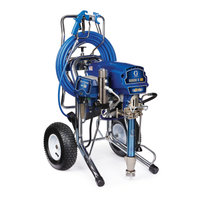How to Mix Drywall Mud for Texture Spraying
Texturing walls and ceilings is a popular design element due to the many decorative applications and unique patterns that can be created. In order to achieve a desired texture finish, there are many contributing factors, such as:
- equipment selection
- nozzle selection
- airflow setting
- material flow setting
- texture materials
Drywall texture materials
In this article, we will review the types of texture materials and provide guidelines for properly mixing these materials as well as review some initial tips on selecting texture equipment.
The most common drywall mud can be purchased in pre-mix or powder form. Regardless of the type of material you are working with, the bottom line is to mix the material correctly and thin until the desired consistency is reached. Additionally, it’s important to pay close attention to the material consistency throughout the job. These essential steps will go a long way to achieving the best texture finishes.
Let’s look further at the characteristics of the two types of texture compound.
Pre-Mixed Joint Compound
Pre-mixed joint compound starts out thick with a paste-like consistency. This type of mud will come in a bucket or box with everything in it that you need. However, most pre-mixed joint compound needs to be thinned to meet the pattern criteria. Some benefit of pre-mixed material is convenience, requiring less mixing and less water needed on the job site.
Powdered Joint Compound
Powdered joint compound, commonly used for wall and ceiling texture, can be broken down further into standard and fast setting. Standard joint compound material is primarily composed of gypsum and used for drywall. On the other hand, fast-setting material contains unique chemical compounds that react and set quickly when exposed to water, hence its name. Typically, most contractors spraying texture do not prefer fast-setting material because of constant and thorough cleanup required and fast setup time.
Powdered material will come in a bag and need to be thinned according to the manufacturer’s directions. Generally speaking, thinner drywall mud creates more output and a finer finish while thicker drywall mud creates less output and a coarser finish. The helpful tips below provide additional information to properly mix and manage texture materials throughout the application.
Working with texture materials
Start On The Thicker Side
You can always add more water to thin out the material. Once water is added, there is no way to “remove” it without starting over. Starting with a thicker material will give you the most control in adjusting the consistency for your desired finish.
Mixing Powder
Always add a few inches of water before adding the powder texture material into the mixing container. This ensures the material will not clump or stick to the side of your mixing container. Always be sure to save some of the powder material just in case the mixture is too thin and needs to be thickened.
Testing Material Consistency
Mixing texture material to the right consistency is crucial for a successful overall finish. One way to test consistency is using the finger test. After mixing, simply run your finger through the center of the material. If the material smoothly folds back on itself, this indicates a medium to light mix. When a mixture does not fold back on itself and a line where your finger was still stands typically means the material is too thick. Refer to the video included above for a visual example of this easy test.
Mix Mud Periodically
Some material may thicken as it sits, which can slow production or impact your finished consistency. Mixing the material frequently throughout the application shears and aerates the material to keep it fresh as you complete the job.
Equipment matters
The Right Mixing Tools
Choosing the right mixing tools is important to achieve the right consistency. Standard drills could be damaged if used to mix heavy muds. When mechanically mixing material, go for a heavy-duty drill or a mixer designed exclusively for texture and drywall mud that provides enough power to get the job done.
Select The Right Sprayer For The Job
The thickness of material can impact the performance of your spray equipment and overall productivity. Most equipment can spray thin material without a problem. However, larger pumps will be more forgiving and productive for a job requiring thicker material to be sprayed. Before buying your next texture sprayer, make sure to check out Choosing the right texture sprayer article.
Related Articles
How to maintain a texture sprayer
Protect your investment and save costs with our detailed guide about proper cleaning, maintaining and storing techniques for airless texture sprayers.
Choosing the right texture sprayer
When you decide to purchase spraying equipment, learn the important questions to ask so you make the right choice.
How to get consistent Drywall Texture Finishes
Achieving a consistent texture pattern is based on three main elements: Material Consistency, Air Pressure Consistency, and Application Technique








